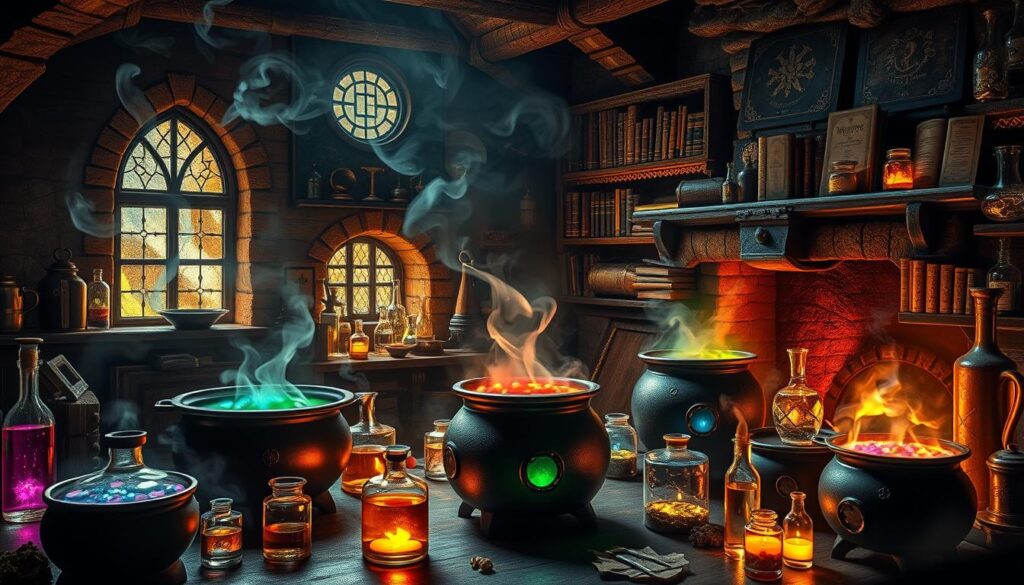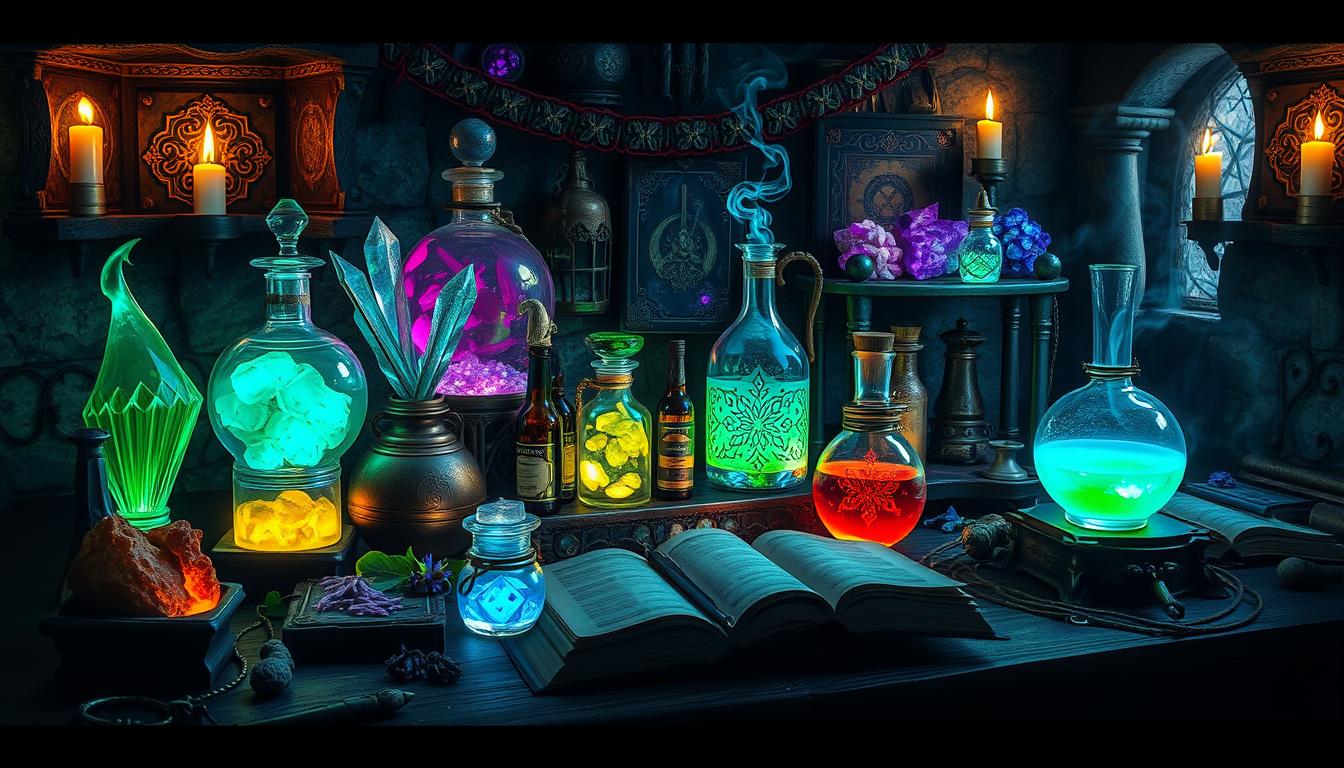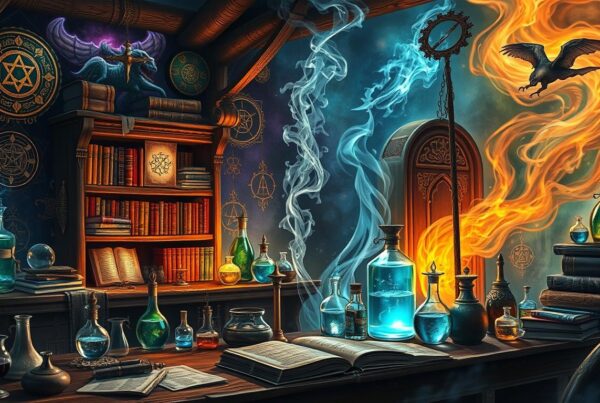Delve into the magical world of potion brewing, where enchanting elixirs and mystical draughts come to life under the skilled hands of Hogwarts‘ master potioneers. With over 50 different types of potions, each with its own unique effects and purposes, the art of potion-making is a fascinating and intricate discipline that requires precision, patience, and a deep understanding of magical techniques and ingredients.
From potions that induce happiness, invisibility, and luck to those that counteract negative effects or heal injuries, the world of potion brewing is vast and diverse. Potioneers at Hogwarts, such as Professor Severus Snape, have dedicated their lives to mastering this art, creating potions that can “bewitch the mind, ensnare the senses, and even put a stopper in death.”
Join us as we explore the secrets and techniques behind the art of potion brewing, uncovering the essential ingredients, brewing methods, and the fascinating history of this magical craft. Whether you’re a budding potioneer or simply curious about the enchanting world of potions, this journey will captivate your imagination and inspire you to appreciate the power and potential of the cauldron.
Key Takeaways
- Potion brewing is a precise and intricate art that requires skill, patience, and knowledge of magical techniques and ingredients.
- There are over 50 different types of potions, each with unique effects and purposes, from healing and luck to counteracting negative effects.
- Hogwarts’ master potioneers, such as Professor Severus Snape, have dedicated their lives to mastering the art of potion brewing.
- Essential ingredients and proper brewing methods are crucial to creating potent and effective potions.
- Exploring the secrets and techniques behind potion brewing can captivate the imagination and inspire appreciation for this magical craft.
Introduction to the Magical World of Potion-Making
Potion-making is a captivating art that has captured the imagination of the wizarding community for centuries. This ancient practice is steeped in mystique and requires a delicate balance of magical ingredients, precise techniques, and unwavering patience. In the magical world, potions hold a special place, serving as powerful tools for healing, transformation, and even mischief.
At the heart of potion-making lies a deep understanding of the magical properties of various ingredients. From the mundane to the exotic, each component plays a crucial role in determining the potency and effects of a potion. Potioneers must possess an encyclopedic knowledge of herbs, plants, and magical creatures, as well as the ability to source and handle these ingredients with care.
The art of potion-making is not for the faint of heart. It demands precision, dedication, and a keen eye for detail. Potioneers must follow complex recipes, carefully measuring and combining ingredients in the correct order and under specific conditions. The slightest deviation can lead to disastrous consequences, ranging from ineffective brews to dangerous explosions.
“Potion-making is a subtle science and an exact art. It requires a disciplined mind, a steady hand, and an unwavering commitment to excellence.” – Professor Severus Snape, Hogwarts School of Witchcraft and Wizardry
In the wizarding community, potion-making is a respected and sought-after skill. Those who excel in this field are often regarded as brilliant minds, capable of unlocking the secrets of the magical world. From the halls of Hogwarts to the apothecaries of Diagon Alley, potioneers are revered for their knowledge, creativity, and ability to create potions that can heal, protect, and transform.
| Potion | Effect | Key Ingredient |
|---|---|---|
| Polyjuice Potion | Allows the drinker to assume the physical appearance of another person | A piece of the person to be impersonated (hair, nail, etc.) |
| Felix Felicis | Grants the drinker temporary good luck | Ashwinder egg |
| Veritaserum | Forces the drinker to tell the truth | Jobberknoll feather |
As we delve deeper into the magical world of potion-making, we will explore the essential ingredients, techniques, and secrets that have been passed down through generations of potioneers. From the basics of cauldron care to the advanced art of brewing fame and fortune, this journey will unveil the true power and potential of potions in the wizarding world.
Essential Ingredients for Potent Potions
When it comes to brewing potent potions, having the right essential ingredients is crucial. Master potioneers understand that the quality and rarity of these components can make all the difference in the effectiveness of their concoctions. From the stomach of a goat to the horn of a unicorn, each ingredient plays a vital role in unlocking the true potential of a potion.
Bezoars: A Potioneer’s Best Friend
Bezoars are small, stone-like objects found in the stomach of goats and other animals. These unassuming items possess a remarkable ability to neutralize most poisons, making them an indispensable tool in any potioneer’s arsenal. When added to a potion, a bezoar can enhance its antidotal properties, providing a reliable safeguard against the deadliest of toxins.
Unicorn Horn: Purity and Power
The unicorn horn is a symbol of purity and power in the magical world. This rare and valuable ingredient is renowned for its ability to cleanse and purify potions, removing any unwanted impurities or side effects. When ground into a fine powder and added to a brew, unicorn horn can amplify the potion’s positive attributes while minimizing any negative consequences.
| Ingredient | Properties | Rarity |
|---|---|---|
| Unicorn Horn | Purifying, Amplifying | Rare |
| Phoenix Feather | Transformative, Enhancing | Very Rare |
| Dragon’s Blood | Regenerative, Strengthening | Rare |
Snake Fangs: Venom and Vitality
Snake fangs are another essential ingredient in many potent potions. These sharp, venomous teeth contain a concentrated dose of the snake’s power, which can be harnessed to imbue a potion with increased vitality and potency. When carefully extracted and prepared, snake fangs can add a level of intensity to a brew that is unmatched by other ingredients.
The art of potion-making is not for the faint of heart. It requires a keen mind, a steady hand, and an unwavering commitment to the craft. Only those who are willing to search far and wide for the most essential ingredients will be able to create truly potent potions.
While bezoars, unicorn horn, and snake fangs are among the most sought-after ingredients in the world of potion-making, they are by no means the only ones. From the delicate petals of the Moonflower to the pulsating essence of a dragon’s heart, the possibilities for creating powerful and transformative potions are endless. It is up to each individual potioneer to explore the depths of their imagination and push the boundaries of what is possible in this fascinating and ever-evolving field.
Mastering the Techniques of Potion Brewing
Brewing potions is an art that requires precision, patience, and a deep understanding of the various techniques involved. Much like cooking, successful potion brewing relies on the right utensils, hands-on skills, and a thorough knowledge of the potion recipe. By mastering these techniques, aspiring potioneers can create powerful concoctions that can heal, enhance, or even transform the drinker.

The Importance of Cauldron Temperature
One of the most critical aspects of potion brewing is maintaining the correct cauldron temperature. Different potions require varying levels of heat, and failing to adhere to these requirements can result in a spoiled or ineffective brew. Some recipes may call for the cauldron to be on or off the fire at specific times, while others may require a constant, steady temperature throughout the brewing process.
For example, when brewing the Pepperup Potion, a cure for the common cold, the cauldron must be kept at a constant simmer for precisely 27 minutes. Any deviation from this temperature can render the potion useless or even dangerous to consume.
Stirring Techniques for Optimal Results
Another crucial element of potion brewing is the stirring technique employed. The number of stirs, the direction of the stirring (clockwise or counter-clockwise), and the speed at which the potion is stirred can all have a significant impact on the final product.
Take the Felix Felicis potion, also known as “Liquid Luck,” for instance. This highly complex potion requires the brewer to stir the mixture seven times counter-clockwise, followed by a single clockwise stir. Failing to follow this precise stirring pattern can result in a potion that has the opposite effect, causing misfortune rather than good luck.
| Potion | Cauldron Temperature | Stirring Technique |
|---|---|---|
| Pepperup Potion | Constant simmer for 27 minutes | Stir clockwise every 3 minutes |
| Felix Felicis | Low heat for the first hour, then increase to medium | 7 counter-clockwise stirs, followed by 1 clockwise stir |
| Polyjuice Potion | High heat for the first 10 minutes, then reduce to low | Stir counter-clockwise continuously for 5 minutes, then add ingredients |
By mastering the techniques of cauldron temperature control and stirring, aspiring potioneers can ensure that their brews are potent, effective, and true to the intended recipe. With practice, patience, and a keen eye for detail, anyone can become a master of the art of potion brewing.
Famous Potioneers Throughout Wizarding History
Throughout the rich tapestry of wizarding history, several notable potion inventors have left an indelible mark on the art of potion-making. These famous potioneers have dedicated their lives to pushing the boundaries of what is possible with magical elixirs, creating groundbreaking concoctions that have transformed the lives of countless witches and wizards.
One such luminary is Zygmunt Budge, a 16th-century potioneer who excelled in his potions class at Hogwarts at the tender age of fourteen. Budge’s crowning achievement was the creation of Felix Felicis, also known as Liquid Luck, a potion so powerful that it is banned from most competitive events, with the exception of potion-making tournaments. Despite his prodigious talent, Budge chose to live a life of isolation on the island of Hermitrae in the Outer Hebrides, where he dedicated his days to perfecting his craft and creating other remarkable potions such as the beautification potion, Doxicide, the laughing potion, and the shrinking solution.
Another celebrated figure in the annals of potion-making is Sacharissa Tugwood, a pioneer in the field of beautification potions. Tugwood’s innovative formulas revolutionized the cosmetic industry in the wizarding world, offering witches and wizards the ability to enhance their appearance with a mere sip of a potion.
“The art of potion-making is a delicate balance of science and magic, requiring equal parts precision and intuition.” – Sacharissa Tugwood
Glover Hipworth, the brilliant mind behind the Pepperup Potion, is yet another notable potion inventor. Hipworth’s creation has become a staple in wizarding households, providing relief from the common cold and other minor ailments.
Other renowned potioneers who have left their mark on wizarding history include:
- Laverne de Montmorency, a gifted potioneer who specialized in love potions
- Regulus Moonshine, creator of the Wolfsbane Potion
- Zenith Xeep, known for her groundbreaking work with healing potions
The contributions of these famous potioneers have not only enriched the magical world but have also inspired countless aspiring potion-makers to follow in their footsteps and continue pushing the boundaries of what is possible with the art of potion-making.
| Potioneer | Notable Creation | Era |
|---|---|---|
| Zygmunt Budge | Felix Felicis | 16th century |
| Sacharissa Tugwood | Beautification Potions | 19th century |
| Glover Hipworth | Pepperup Potion | 20th century |
| Laverne de Montmorency | Love Potions | 18th century |
| Regulus Moonshine | Wolfsbane Potion | 20th century |
| Zenith Xeep | Healing Potions | 21st century |
The Art of Potion Brewing: Secrets from Hogwarts’ Master Potioneers
Throughout the history of Hogwarts, the school has been graced with the presence of exceptional Hogwarts potioneers who have left an indelible mark on the art of potion brewing. Two of the most renowned figures in this field are Professor Severus Snape and Professor Horace Slughorn, each with their own unique approaches and ingenious recipes.
Professor Severus Snape’s Unique Approaches
Severus Snape, known for his enigmatic personality and exceptional skills, developed innovative methods in potion-making. His modified recipes, found scribbled in the margins of his old potions textbook, often yielded superior results compared to the original instructions. Snape’s expertise in crafting the complex Wolfsbane Potion in 1993 elevated the knowledge of potions from mere chemistry to an art form, highlighting his unparalleled prowess in the field.
Horace Slughorn’s Ingenious Recipes
Professor Horace Slughorn, who taught potions before and after Snape, was celebrated for his ingenious recipes and extensive knowledge of rare ingredients. His mastery in concocting love potions and the coveted Felix Felicis made him a highly respected figure among Hogwarts potioneers. Slughorn’s return to Hogwarts in 1996 saw him reforming the Slug Club, nurturing the talents of promising students like Hermione Granger, Ginny Weasley, and Cormac McLaggen.
| Potioneer | Unique Approaches | Notable Potions |
|---|---|---|
| Severus Snape | Modified recipes, innovative methods | Wolfsbane Potion |
| Horace Slughorn | Ingenious recipes, rare ingredients | Love Potions, Felix Felicis |
The contrasting teaching styles of Snape and Slughorn created a dynamic learning environment for aspiring Hogwarts potioneers. While Snape was known for his strict demeanor and bias towards Slytherin students, Slughorn was described as a more accommodating and popular teacher, leading to improved performance by students under his tutelage. Together, these master potioneers have left an enduring legacy, inspiring generations of witches and wizards to explore the fascinating world of potion brewing.
Potions for Everyday Use and Extraordinary Occasions
In the magical world, potions serve a wide array of purposes, from treating common ailments to granting extraordinary abilities. Whether you’re a seasoned potioneer or a curious beginner, understanding the various potions and their applications is essential. Let’s explore some of the most notable everyday potions and extraordinary concoctions.

Pepperup Potion: Cure for the Common Cold
The Pepperup Potion is a staple in wizarding households, providing relief from the common cold. This vibrant red potion, when consumed, causes steam to emanate from the drinker’s ears for several hours. Despite the odd side effect, it effectively clears the sinuses and provides an instant boost of energy, making it a go-to remedy for those seeking a quick recovery from the sniffles.
Felix Felicis: Liquid Luck
Felix Felicis, often referred to as Liquid Luck, is an extremely rare and powerful potion that grants the drinker temporary luck in all their endeavors. The golden, molten-like liquid is notoriously difficult to brew, requiring six months of careful preparation. When consumed, Felix Felicis instills a sense of confidence and optimism, guiding the drinker to make the right choices and seize opportunities that would otherwise be missed. However, it is crucial to use this potion sparingly, as overreliance on luck can have dire consequences.
Amortentia: The Most Powerful Love Potion
Amortentia, the most potent love potion in existence, is a fascinating and dangerous creation. With its distinctive mother-of-pearl sheen and steam rising in characteristic spirals, Amortentia emits a unique aroma that varies from person to person, reflecting what attracts them most. While it cannot create genuine love, the potion induces a powerful infatuation, causing the drinker to become obsessed with the person who administered it. Due to its potency and potential for misuse, the brewing and use of Amortentia are strictly regulated by the Ministry of Magic.
| Potion | Effects | Brewing Difficulty |
|---|---|---|
| Pepperup Potion | Cures the common cold, causes steam from ears | Moderate |
| Felix Felicis | Grants temporary luck in all endeavors | Extremely difficult (6 months) |
| Amortentia | Induces powerful infatuation, smells unique to each person | Advanced |
Whether you’re seeking relief from everyday ailments or yearning for a taste of extraordinary power, the world of potions offers a fascinating array of possibilities. As you delve deeper into the art of potion-making, remember to approach each brew with caution, precision, and a healthy respect for the incredible magic that lies within.
Advanced Potion-Making: Challenges and Triumphs
Advanced potion-making is a realm that presents numerous challenges, even for the most skilled potioneers. Complex potions require precise measurements, rare ingredients, and unwavering patience. One such potion is the Felix Felicis, also known as liquid luck, which demands a brewing time of six months and ingredients like Ashwinder egg, Squill bulb, and Murtlap tentacles. The potion, invented by Zygmunt Budge, is considered a crowning achievement in advanced potion-making.
Another example of a challenging potion is the Polyjuice Potion, which allows the drinker to assume the appearance of another person. The brewing process is exceptionally difficult, requiring a month of preparation and rare ingredients such as boomslang skin and bicorn horn. The Wolfsbane Potion, developed to help werewolves retain their human minds during transformation, is another testament to the triumphs of advanced potion-making.
“The art of potion-making is a delicate balance between precision and innovation. It takes years of study and practice to master the most complex potions, but the rewards are well worth the effort.”
– Horace Slughorn, Potions Master at Hogwarts
Successful brewing of advanced potions requires not only skill but also a deep understanding of the magical properties of ingredients and their interactions. Potioneers must be able to adapt to unexpected challenges and think creatively to overcome obstacles. Some of the most significant triumphs in advanced potion-making include:
- The development of the Draught of Living Death, a powerful sleeping potion
- The creation of the Mandrake Restorative Draught, which can cure petrification
- The invention of the Wiggenweld Potion, capable of reversing the effects of the Draught of Living Death
| Potion | Difficulty Level | Brewing Time | Notable Ingredients |
|---|---|---|---|
| Felix Felicis | Extremely Difficult | 6 months | Ashwinder egg, Squill bulb, Murtlap tentacles |
| Polyjuice Potion | Very Difficult | 1 month | Boomslang skin, Bicorn horn, Lacewing flies |
| Wolfsbane Potion | Difficult | 1 week | Aconite, Valerian root, Dittany |
Despite the challenges, the triumphs of advanced potion-making continue to inspire and motivate aspiring potioneers. The pursuit of knowledge and the desire to push the boundaries of what is possible drive the most dedicated practitioners to explore new frontiers in the art of potion-making.
The Importance of Precision and Patience in Potion Brewing
In the fascinating world of potion brewing, two qualities stand out as essential for achieving consistent and potent results: precision and patience. Master potioneers understand that the slightest deviation from a recipe or rushing through the brewing process can lead to disastrous consequences. By honing these skills, aspiring potioneers can elevate their craft and create potions that are both effective and safe.
Measuring Ingredients: A Critical Skill
One of the most crucial aspects of potion brewing is the accurate measurement of ingredients. Even a slight miscalculation can alter the delicate balance of a potion, rendering it useless or even dangerous. Potioneers must develop a keen eye for detail and a steady hand when weighing and measuring each component. Some ingredients, such as unicorn horn or snake fangs, require specific preparation methods to maintain their potency, adding another layer of complexity to the process.
To illustrate the importance of precise measurements, consider the following table comparing the effects of a correctly brewed Pepperup Potion to one with slight deviations:
| Ingredient | Correct Measurement | Incorrect Measurement | Effect |
|---|---|---|---|
| Bicorn Horn | 2 grams, finely powdered | 2.5 grams, coarsely ground | Potion fails to relieve congestion |
| Mandrake Root | 1 medium-sized root, chopped | 1 small root, sliced | Potion causes excessive drowsiness |
| Salamander Blood | 3 drops | 5 drops | Potion induces fever and chills |
Timing is Everything: Allowing Potions to Mature
In addition to measuring ingredients accurately, potioneers must exercise patience when brewing potions. Many potions require specific brewing durations and maturation periods to reach their full potential. Rushing the process or cutting corners can result in a subpar or even hazardous potion. For example, Felix Felicis, the notorious “liquid luck” potion, must be allowed to mature for six months after brewing to achieve its desired effects.
“Patience is a virtue, especially in the art of potion making. A potion brewed in haste is a potion wasted.” – Professor Severus Snape
Aspiring potioneers should cultivate patience and respect the time-honored traditions of their craft. By allowing potions to mature properly, they ensure that each brew reaches its full potential and delivers the intended results.
Potion Safety: Avoiding Common Mishaps and Disasters
Potion safety is of utmost importance for all aspiring potioneers. Even the most experienced brewers can fall victim to common mishaps and brewing disasters if they don’t take the necessary precautions. From adding ingredients in the wrong order to stirring in the incorrect direction, these seemingly small errors can lead to toxic fumes, explosions, or even poisonous concoctions.
To ensure potion safety and avoid these dangerous situations, it’s crucial to follow recipes meticulously and maintain a clean, organized workspace. Always wear protective gear, such as gloves and goggles, when handling hazardous ingredients. Proper labeling and storage of potions are also essential to prevent accidental misuse or contamination.
“Constant vigilance!” – Alastor “Mad-Eye” Moody, emphasizing the importance of staying alert and cautious in all aspects of the wizarding world, including potion brewing.
Even with the best intentions, accidents can happen. Take, for example, the incident at the Ministry of Magic on October 28, 2008, when a witch attempted to assault Ron Weasley with a love potion in a lift. Thanks to Ron’s quick thinking and defensive magic, he managed to stupefy the witch, rendering her unconscious. This incident highlights the importance of being prepared for the unexpected and knowing how to react in a potion-related emergency.
| Common Potion Mishaps | Consequences | Prevention Measures |
|---|---|---|
| Adding ingredients in the wrong order | Toxic fumes, explosions, or poisonous concoctions | Follow recipes meticulously |
| Stirring in the incorrect direction | Ineffective or dangerous potions | Pay close attention to stirring instructions |
| Failing to maintain proper cauldron temperature | Ruined potions or hazardous reactions | Use a reliable heat source and monitor temperature |
| Mishandling hazardous ingredients | Injuries or contamination | Wear protective gear and handle ingredients with care |
By prioritizing potion safety and staying vigilant, you can minimize the risk of common mishaps and brewing disasters. Remember, a well-prepared and cautious potioneer is a successful one!
Innovations in Potion-Making: Recent Discoveries and Developments
The world of potion-making is constantly evolving, with new discoveries and innovations pushing the boundaries of what is possible. Recent advancements in the field have led to exciting developments that promise to revolutionize the art of brewing potions. From experimental ingredients to cutting-edge techniques, potioneers are exploring uncharted territories in their quest to create more potent, efficient, and versatile concoctions.
Experimental Ingredients: Pushing the Boundaries
One of the most significant areas of potion-making innovation lies in the realm of experimental ingredients. Researchers are constantly seeking out rare plants, magical creatures, and exotic substances that can enhance the effects of existing potions or give rise to entirely new ones. For example, the recently discovered Moonflower, which only blooms under the light of a full moon, has been found to amplify the potency of healing potions when added in precise quantities.
Other notable experimental ingredients include:
- Phoenix tears, known for their regenerative properties
- Basilisk venom, a highly potent and versatile ingredient
- Mermaid scales, which can imbue potions with underwater breathing capabilities
New Brewing Techniques: Efficiency and Efficacy
In addition to exploring new ingredients, potioneers are also developing innovative brewing techniques to streamline the potion-making process and improve the overall quality of their creations. One such technique involves the use of enchanted cauldrons, which can maintain precise temperatures and stir the potion automatically, ensuring consistent results every time.
“The introduction of enchanted cauldrons has been a game-changer for potion-making. It allows us to focus on the intricacies of the recipe without worrying about the minutiae of the brewing process.” – Horace Slughorn, Potions Master
Another groundbreaking technique is the application of advanced stirring patterns, which can alter the magical properties of a potion by influencing the way the ingredients interact with one another. By carefully choreographing the stirring sequence, potioneers can unlock hidden potential within their brews and create more targeted, effective potions.
| Technique | Benefit |
|---|---|
| Enchanted Cauldrons | Maintains precise temperatures and automatic stirring |
| Advanced Stirring Patterns | Alters magical properties and unlocks hidden potential |
As the field of potion-making continues to evolve, it is clear that these recent discoveries and developments will have a profound impact on the wizarding world. From more effective healing potions to entirely new categories of magical elixirs, the possibilities are truly endless. With each passing year, potioneers are pushing the boundaries of their craft, ensuring that the art of potion-making remains a vital and ever-evolving discipline within the magical community.
Conclusion: The Enduring Fascination of Potion Brewing
The potion brewing fascination has captivated the hearts and minds of wizards and witches for centuries, from the hallowed halls of Hogwarts to the bustling streets of Hogsmeade. This magical art, steeped in history and tradition, continues to inspire new generations of potioneers, each eager to leave their mark on this enduring legacy.
From the meticulous precision of Severus Snape to the ingenious creativity of Horace Slughorn, the master potioneers of Hogwarts have left an indelible impact on the craft. Their secrets and techniques, passed down through the ages, serve as a guiding light for aspiring brewers, illuminating the path to potion mastery.
As the wizarding world evolves, so too does the art of potion-making. Innovations in ingredients and brewing techniques push the boundaries of what is possible, while the timeless principles of patience, precision, and dedication remain at the heart of every successful potion. With each passing year, the potion brewing fascination grows stronger, a testament to the enduring power of this magical art.
In the end, the legacy of potion brewing is one that will endure for generations to come. As long as there are curious minds and passionate hearts, the cauldrons of Hogwarts will never run dry, and the magic of potions will continue to enchant and inspire wizards and witches alike.



